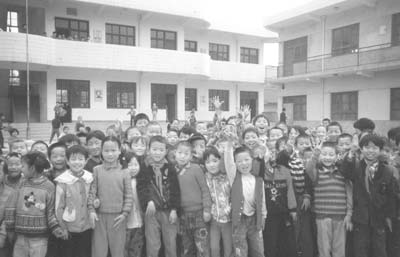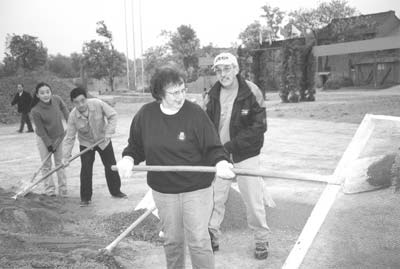Helped build a school in China
“Grandmothers shouldn’t be doing work like this,” the little Chinese boy said as he took the shovel from me and laid it down. With his small hand in mine, he led me over to a log and indicated I should sit down.
I knew this 3-year-old child. We had met several days earlier when our group of Global Volunteers walked the red clay “main” road in An Shang, China, a village over two rough hours’ drive west of Xi’an.
Eleven of us were in the village in April-May ’02 to work with Chinese builders in constructing a 3-story elementary school. The existing school, already serving 400 students, was overcrowded.
In addition to working at least five hours each day, weather and building supplies permitting, we visited other villages, went to the newly famous Famen Temple and were entertained by the villagers with music and performances.
Global Volunteers offers a unique way to travel — not a tour, not a cruise, not independent travel but a way of meeting and working with people of a different culture on their home turf and getting to know and appreciate that culture, unlike a “see six countries in seven days” foreign experience.
There are several organizations providing similar immersion programs, often in construction projects or teaching conversational English. Among these are Elderhostel, Habitat for Humanity and Earthwatch.
In China, it didn’t take any time at all to develop a taste for sugared tomatoes twice a day plus scallions, tofu, onions and noodles (made on a large, ancient machine) as well as eight other dishes at each meal.
Nor did it take long for us to realize how much our visit was appreciated. A 2-hour welcoming meeting in Xi’an was attended by the contractor, the village Communist leader, the school principal and other men important to the project, all of whom expressed delight that we were part of the Project Peace program.
“You are not just building a school but building a great bridge over the Pacific Ocean,” said one.
We all sat up taller on hearing the generous compliments. One doesn’t hear such comments zipping from country to country on a tour bus nor flying over a country wondering what river is winding its way through the distant fields below.
We’d been warned by the Global Volunteers office to expect husk mattresses and, if we were fortunate, a “sun” shower, an outdoor plastic contraption. Instead, we arrived at the three houses set aside for us to find real showers, new mattresses, a new dining table with enough chairs for 15 (we had a team leader and two interpreters), beautiful new quilts and freshly plastered walls.
An Wei, our primary host and president of the Sino-American Society, marched around checking things out; within days other improvements for our comfort appeared.
American flags flew high and proud over the three houses in which we stayed. At the school site, Chinese and American flags were hoisted to exactly the same height. Across the “main” street, banners welcomed us.
This was a simple village. There were two tiny stores, each with a door and one small window. Daily, two farmers sold fruits and vegetables from the backs of their vehicles. Gossip from neighboring villages was shared freely.
(My first trip to China was in 1982. At that time, China was a gray-and-blue country because of the required Maoist garb; this time, brilliant red, blue, green and yellow clothing brightened the village.)
When we walked the dirt streets during our leisure hours, we often had a sensation of being followed. Turning around, we usually found 10 to 15 children dancing along behind us, anxious to say “Hi,” about the limit of their English, as was our Chinese “Ni hao.”
Of all our encounters, those with the children were the highlights. We watched them entertain themselves for hours with a game like hopscotch/musical chairs/Simon says, needing only a segment of hard-packed dirt and a piece of chalk to mark positions. Eager eyes and friendly hands kept inviting us to join in. Tossing Frisbees was our contribution, and it quickly was mastered by the children.
Each day, as we passed people sitting at the doors of their homes, we were greeted with, “Have you eaten yet?” We always answered, “Yes, thank you,” to this traditional Chinese way of saying a friendly “Hello.” Other times, we were invited into homes and served tea and cookies.
The “leading ladies” of the village came by one evening and took our clothing, which needed washing, and laundered it by hand.
One older man, sitting on a kang (a high brick bed) in his 2-room house, told of his and the villagers’ lives during the Great Leap Forward and the Cultural Revolution, both extremely difficult economic and social times for millions of Chinese. His grandchildren sat wide-eyed listening to him share with us stories they’d never heard him tell.
Without quite realizing it, we absorbed economic lessons, social lessons and an appreciation for the music and architecture, in addition to developing building skills, not to mention a few blisters and sore shoulders.
On our last night we simply had to have a marshmallow roast! Our team leader made two trips to Xi’an to buy marshmallows. The first sacks contained tiny squares like those we use in hot chocolate; the second purchases were better but still smaller than those we use at home. We were intrigued by the holes drilled through each one, but they were handy for the insertion of the chopsticks we used as our “sticks.”
Chinese children looked askance at us for toasting the marshmallows, but they eagerly ate the finished product. A sickle of moon and bright Venus overhead, trees hovering nearby, and faces of all ages shining in the flaming firelight — it was an emotional time.
Then we all sang. Surprisingly, while the words in some cases were different, many of the tunes were the same. “Frere Jacques” was sung in French, Chinese and English. How I wished for the world’s diplomats to be with us!
On our last day, our luggage was picked up early. Our bus disappeared down the street toward the village center. As we followed the bus we heard drums, and people were lined up along the sides of the street. Our women friends, the shoemakers and singers, coaxed us into two lines before passing out embroidered soles to each of us, hugging us as they did so. (I’m referring to the inner soles for shoes that the women make to sell. They are lovely and intricate and darned hard to do, as I found out.)
Large cymbals clashed together by eager hands joined the beating drums as the villagers — young and old, fit and feeble — waved us on our way. We were now part of the village “story” to be recalled around fires, mah-jongg and card games for years to come. What would the 3-year-old boy tell his grandchildren about the American grandmothers who shoveled gravel to help build a school?
Our 3-week program cost about $2,000 plus about $1,200 in round-trip airfare from Redding, CA, to Xi’an, China. We spent all of our time in the village except for two days at the beginning and four days in Xi’an in the middle. In addition to this unique and wonderful experience, our airfare and program costs were tax deductible. It surely beat any typical tour on which I’ve ever been!
Global Volunteers (375 E. Little Canada Rd., St. Paul, MN 55117-1628; phone 800/487-1074 or visit www.globalvolunteers.com) has 2- and 3-week educational or construction projects in Africa, Asia, Latin America and Europe and one-week programs in the U.S.
Chloe Ryan Winston
Redding, CA


